Five People Who Changed Kite History
BENJAMIN FRANKLIN
In June of 1752 Benjamin Franklin began to study the atmosphere with kites,which led to extensive meteorological work that continued for 150 years, until the airplane was developed.
Franklin was trying to determine whether the earth and sky functioned like the conducting layers of a Leyden jar in the presence of an electric charge. 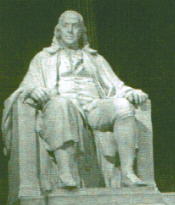
The memorably demonstrated experiment in Philadelphia did prove that lightning is electricity. In June of 1752 the experiment was begun in some secrecy, with only the assistance and witness of Franklin’s 21 year old son. Franklin dreaded the possibility of the ridicule which too commonly attends unsuccessful attempts in science.
Franklin waited until there was a storm and then proceeded to fly his kite made of silk, the silk would tolerate the pouring rain better than other materials available at that time. They waited a very long time and even considered calling off the experiment when Ben noticed a few threads of silk tied to the key were standing straight out, he then touched the back of his knuckle to the key and felt a shock. His enormous pleasure at proving his theory is legendary.
It’s amazing that Franklin was not killed during this experiment, as others who tried to reproduce it were. Many people trying the experiment according to Franklin instructions were knocked on their butts. Even Franklin admits that he had killed many a turkey in his trials and had himself been knocked unconscious by a charge from one of his Leyden jars. He eventually learned to ground his wires.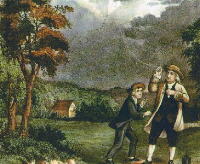
Franklin’s interest and experience with kites were not all work. Traction, the use of kites to pull boats, carriages, sleds, and other objects is one of their earliest applications. One of the first instances recorded in the west is a boyhood experience of Benjamin Franklin.
One fine summer day young Ben was out flying a paper kite. He came upon a pond which was a mile broad. He tied his kite off and proceeded to swim, and think about his kite. He wanted to combine these two pleasurable activities.
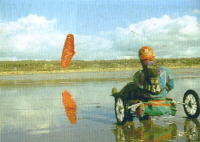 A brief account in young Franklin’s own words from his autobiographical writings goes as follows:”…I found that by lying on my back and holding the stick in my hands. I was drawn along the surface of the water in a very agreeable manner. Having then engaged another boy to carry my clothes round the pond, to a place which I pointed out to him on the other side. I began to cross the pond with my kite, which carried me quite over without the least fatigue and with the greatest pleasure imaginable.” During the winter Franklin also used kites to pull him along while ice skating.
A brief account in young Franklin’s own words from his autobiographical writings goes as follows:”…I found that by lying on my back and holding the stick in my hands. I was drawn along the surface of the water in a very agreeable manner. Having then engaged another boy to carry my clothes round the pond, to a place which I pointed out to him on the other side. I began to cross the pond with my kite, which carried me quite over without the least fatigue and with the greatest pleasure imaginable.” During the winter Franklin also used kites to pull him along while ice skating.
There has been a great resurgence of kite traction over the last few years, with New Zealand’s Peter Lynn’s invention of the kite buggy: a low riding three wheeled buggy that is steered with the feet while the pilot is pulled along by a variety of kites that he/she flies. It is not uncommon to reach speeds of 30mph or more.
HOMAN WALSH
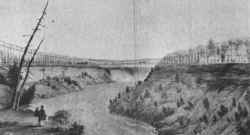 In 1847 in what is now known as the city of Niagara Falls it was decided that if they had a bridge spanning the great gorge it would be a big boost to the local economy. They had the technology to build the bridge, but were at a loss as to how to get that very important first line across the gorge.The steep cliffs, mighty rapids, and frigid swirling winds hindered any conventional methods.
In 1847 in what is now known as the city of Niagara Falls it was decided that if they had a bridge spanning the great gorge it would be a big boost to the local economy. They had the technology to build the bridge, but were at a loss as to how to get that very important first line across the gorge.The steep cliffs, mighty rapids, and frigid swirling winds hindered any conventional methods.
They finally came up with an idea. If someone could fly a kite across the gorge they would have that very important first line. A lot of people attempted the crossing, but only 10 year old Homan Walsh succeeded. First young Homan had to go to the lower river and cross on a ferry, since the prevailing winds came from the Canadian side. He then back tracked to the cliff chosen by the engineer, the narrowest part of the gorge, about 800 feet, were he lofted his kite, aptly named “the Union” , into the air. He released more and more line as the kite ascended and drifted toward the distant shore. As it hung proudly above the cliffs, Homan merely had to wait until sunset when the winds would subside and his kite would begin to drop. Sunset came but the kite remained aloft.
Bonfires were built on both sides of the gorge by anxious spectators. As darkness fell, Homan wondered if his kite would ever come down. During the night as the winds diminished he felt his line slacken, and he began reeling it in, and was very disappointed when a frayed line appeared. The line had fallen into the gorge where the sharp ice made it shred instantly. In fact, so heavy was the onslaught of ice that he was held virtually captive on the other side for 8 days, until favorable conditions allowed him to cross the river and retrieve his kite. His family was not very happy with the fact that 10 year old Homan was stranded.
A nice family took him in and cared for him until he was able to return home. After some necessary repairs to his kite his second attempt was a roaring success.
After they secured the initial kite line across the gorge progressively heavier and heavier line was fed across until a steel cable connected the distant cliffs, from this cable the bridge was constructed. For all his efforts Homan Walsh was awarded a cash prize of ten dollars, and in 1847 that was a lot of money.
A lesser known fact was that hundreds of years before Homan, Leonardo da Vinci had also devised the use of kites to help in bridge construction.
ALEXANDER GRAHAM BELL
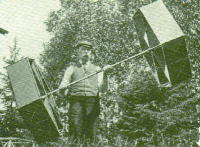 The early years of the twentieth Century were a golden era of experiments with three-dimensional rigid kites such as the box kite and the Conyne kite. There was a purpose behind this kite-building mania. Most of the experimenters were looking for a design that would be strong enough and light enough to function as a heavier-than-air flying machine. Among the principal researchers was Alexander Graham Bell, already quite famous as the inventor of the telephone, who developed the tetrahedral kite.
The early years of the twentieth Century were a golden era of experiments with three-dimensional rigid kites such as the box kite and the Conyne kite. There was a purpose behind this kite-building mania. Most of the experimenters were looking for a design that would be strong enough and light enough to function as a heavier-than-air flying machine. Among the principal researchers was Alexander Graham Bell, already quite famous as the inventor of the telephone, who developed the tetrahedral kite.
The tetrahedron is theoretically the strongest, most rigid symmetrical structure that can exist in nature. Cover any two sides of the tetrahedron with fabric, and you have the basic cellular structure that Bell used in his kites.
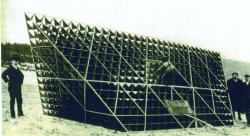 Using tetrahedron cells to construct a kite has a number of advantages. The cells are rigid, anddon’t need extra bracing to maintain their shape. The kite itself is exceptionally strong and stable. A kite can be built to almost any size simply by connecting several tetrahedron cells together, and you don’t need to use thicker and stronger sticks as the kite grows bigger.
Using tetrahedron cells to construct a kite has a number of advantages. The cells are rigid, anddon’t need extra bracing to maintain their shape. The kite itself is exceptionally strong and stable. A kite can be built to almost any size simply by connecting several tetrahedron cells together, and you don’t need to use thicker and stronger sticks as the kite grows bigger.
Bell, himself, built gargantuan man-carrying kites made of thousands of interlocking tetrahedron cells. One was made of 3,393 cells! The town near Bell’s laboratory gained a new industry as workmen and seamstresses turned out thousands of silk covers.
Bell was a gentle and humane man who was concerned about the safety of his aeronauts. Hechose to make the first man-carrying attempts over the waters of Baddeck Bay in a craft that would float, piloted by a man who could swim. Bell looked for ways to create increased wind pressure by using various forms of ground-power assisted flight. When the winds were light and he needed assistance flying one of his giant kites, he often used galloping horses to tow the kite into the air.
WRIGHT BROTHERS
Every school child learns that Wilbur and Orville Wright are credited with the invention (in 1903) of the airplane. What most school children don’t realize is that the Wright brothers were also skilled in kite flying and riding. It was their years of kite flying that directly led to the invention of the airplane.
invention (in 1903) of the airplane. What most school children don’t realize is that the Wright brothers were also skilled in kite flying and riding. It was their years of kite flying that directly led to the invention of the airplane.
The early experiments of the Wright brothers involved studying buzzards and other birds, and flying kites. At this same time, Lawrence Hargrave was devising the first box kite in Australia. Hargrave had weather studies and possible military purposes in mind while experimenting with box kite designs. As soon as the Wright Brothers saw and flew a Hargrave box, they knew what shape their manned flying machine should take.
Orville and Wilbur flew Hargrave kites as gliders at Kitty Hawk, North Carolina. This is where the first manned flights would occur several years later. One day while flying box kites at Kitty Hawk, The brothers discovered that the kites provided enough lift to be able to lift a man off the ground. 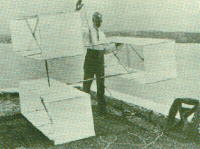
In August of 1899, they built a biplane kite, also known as a warping kite. They discovered that by varying the position of the four lines attached near the kite’s extremities, they could simulate the twisting of the wings of a soaring bird. This they called wing-warping lateral control; a method that was to characterize Wright’s airplane for years to come.
The Wright’s version of an aircraft had an important difference from that of Hargrave and others of that period who were looking for a safe, stable flight. Wilbur and Orville were looking for an unstable craft that could be controlled by steering. They achieved the ability to steer with the invention of their wing-warping lateral control. In 1900, they built their “No. 1 Glider”, which they principally flew as a kite. 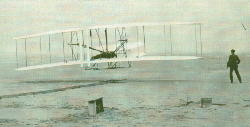
In 1903, after many months of trials, the gas-powered “Wright Flyer” flew and became the world’s first manned flying machine.
Alexander Graham Bell also produced a manned flying machine. In 1908, five years after the Wright Brother’s maiden flight, Bell was the first to fly the skies over Canada. Bell’s aircraft was also a biplane design. In fact, during the first decade of the Twentieth Century, Bell’s experiments received so much more notoriety than those of the Wright Brothers that many people believed that Alexander Graham Bell rather than the Wright Brothers invented the airplane.
It was due to the experiments by Bell and the Wright Brothers using human riders, that the big breakthroughs in powered flight occurred.
PAUL GARBER
Kites have been successfully used for military purposes for thousands of years. In 1942, Lieutenant Commander Paul E. Garber was an officer on the carrier USS Block Island. He was assigned to the US Navy’s Special Devices Division to make aircraft recognition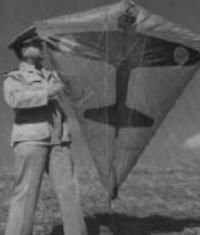 models. Garber had been flying kites since the age of five and had written a kite flying manual for the Boy Scouts in 1931. At the age of nine, he even witnessed one of the early flights of the Wright Brothers.
models. Garber had been flying kites since the age of five and had written a kite flying manual for the Boy Scouts in 1931. At the age of nine, he even witnessed one of the early flights of the Wright Brothers.
One day he made a kite and challenged a gun crew to use it as a target. This was more realistic than using clouds as targets as had previously been done. To the crew’s exasperation, they had to fire many rounds before making a direct hit. The captain of the ship was so impressed with the demonstration that he ordered Paul to build more target kites.
As the gunners improved their shooting accuracy, Garber modified an Eddy Kite (diamond shaped) that could swing across the sky, loop, dive, climb and do figure eights. The five foot kite was controlled by a flier with a twin spool reel complete with a control bar and brake. A ventral fin and rudder on the kite provided the directional control. A silhouette of a Japanese Zero or German Focke-Wulf-190 plane silkscreened on a light blue rayon sail.
At a distance (flown at 200 feet) the blue background disappeared, revealing only the kite’s silhouette of an aircraft. Eventually the wooden struts of the target kites were replaced with aluminum so they would sink after being shot down. 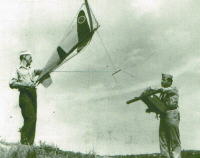
The Garber Target Kite was credited with saving an aircraft carrier. One morning the gunners were stationed in their bays for target practice when a lookout sighted a Japanese torpedo plane approaching from a bank of clouds. Had they not been ready, the plane would have seriously damaged the carrier. Instead the gunners were able to down the Japanese plane. Hundreds of thousands of such kites were used in training gunners, at a great savings to the US Government in money and manpower.
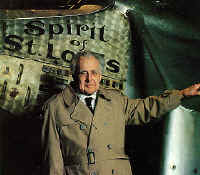 Garber also used winged, triangular box kites (signal kites) to pass important papers from ship to aircraft. A cable with the package attached was strung between two kites. A passing aircraft would snare the cable with a hook and deliver the package to it’s destination.
Garber also used winged, triangular box kites (signal kites) to pass important papers from ship to aircraft. A cable with the package attached was strung between two kites. A passing aircraft would snare the cable with a hook and deliver the package to it’s destination.
Paul Garber remained interested and active in flight and kites after WW II he became the first director of the Smithsonian Institution Air Museum, late renamed the Air and Space Museum. He is credited with collecting an incredible kite collection for the museum. No man has ever done so much to popularize the kite as an educational instrument.
He also lobbied Congress to remove the anti-kite legislation from the books in Washington, DC, and other areas. Thanks to Paul Garber there is the spectacular Smithsonian Institution Kite Festival each spring on the Mall at the Washington Monument. This spring will be it’s 30th anniversary. Now people are able to fly year round at the site, which is currently the home flying field for the local kite club, the Wings Over Washington.
